CPC, NDP stall while Liberals regain some support
Our most recent data suggests the Conservative Party of Canada (CPC) and the Liberal Party of Canada (LPC) are now tied in popular support, nationally. Unlike previous weeks, there is no change in support for the CPC, but the LPC appears to have made a slight gain at the expense of the New Democratic Party (NDP). Conservative support remains virtually unchanged at 33% compared to 34% last week. The Liberals have gained back the support they lost last week and are now also sitting at 33% nationally, up from 30%. The NDP’s support has slipped from 24% last week to 21%.
Turning to the regional races, the situation in Ontario remains similar to last week. The Liberals and Conservatives are essentially tied at 35% and 34% respectively, while the NDP remains in the mid-20s at 23%. In Quebec, the situation has turned in the Liberals’ favour. The Liberals are up significantly compared to last week, from 29% to 36%. Meanwhile, CPC and NDP support in the province has fallen. Last week the CPC sat at 21% and the NDP at 17%. Now, CPC support is at 19% and the NDP at 13%. The BQ’s share of support remains virtually unchanged at 27%. The race in BC remains competitive between the Liberals (31%), the Conservatives (30%) and the NDP (30%).
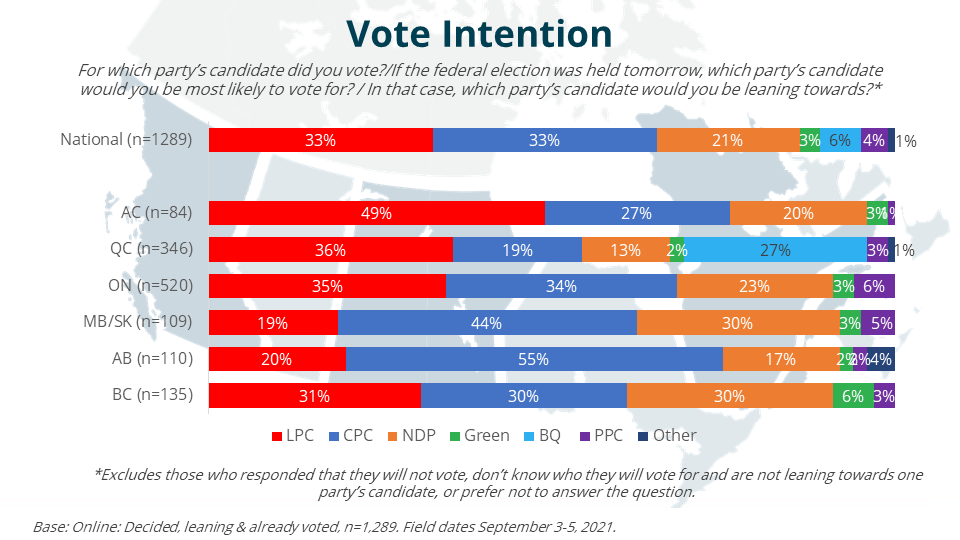
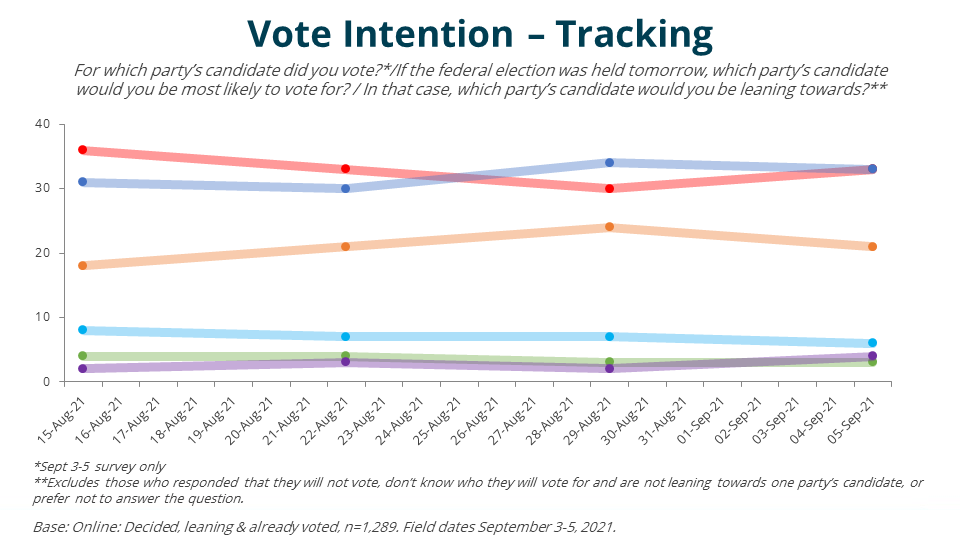
Tracking Vote Intention by Demographics
After four weeks of data collection, we have charted vote intention by gender, age and area over the past month.
At the outset of the campaign, the Liberals led among both men and women. Over the last four weeks, Liberals have lost and then regained support among women. The CPC seemed to be building support among women until this week, when their vote share fell back below 30%.
Among men, the Conservatives have made steady gains at the Liberals’ expense. The NDP experienced a slight increase in support late in August among both men and women, but as of this week are in a similar position to the outset of the campaign among both groups.
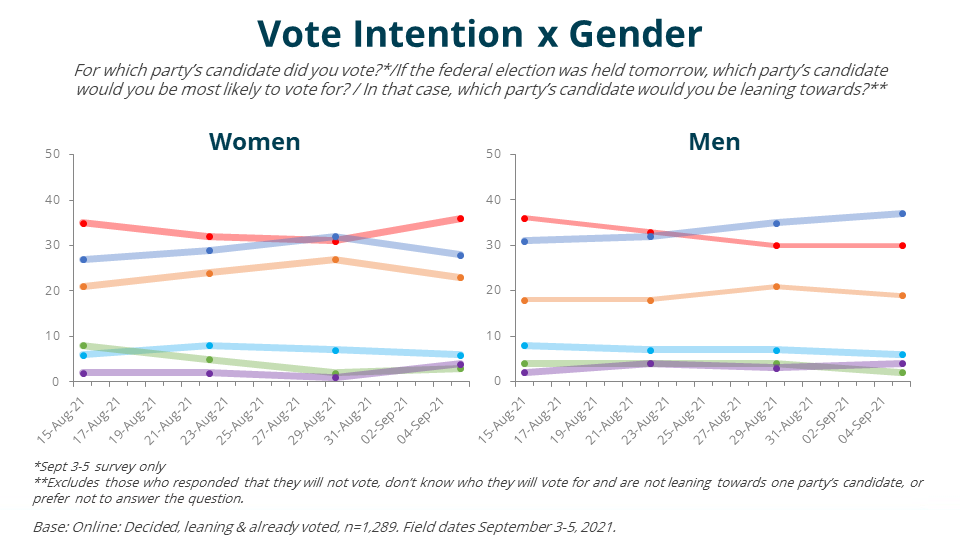
Currently, the Liberals and NDP are virtually tied among 18- to 34-year-olds. The NDP saw a massive spike in late August, which has since receded. Of note, support for the People’s Party of Canada has risen among the 18 to 34 cohort and is now exceeds support for the Green Party.
Among 35- to 54-year-olds, the Liberals led at the outset of the campaign, but Conservatives gained in the first few weeks as the Liberals lost support. The race among this age group is currently a statistical tie between the CPC and LPC.
The CPC gained the lead among the 55+ age group in late August, and remains in the lead. Liberal support dropped in the initial weeks of the campaign, but has since risen slightly.
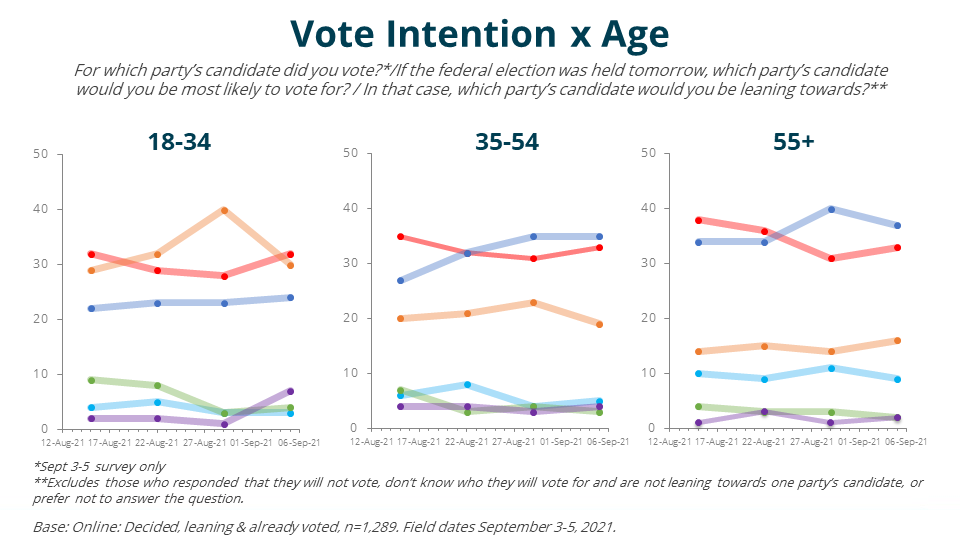
Throughout the campaign, the Liberals have maintained the lead in urban Canada. The CPC and NDP both gained support over the course of August, but that support seems to have levelled off. In the final weeks of the campaign, the NDP will likely look to rebuild that momentum to keep the party competitive in Liberal/NDP swing ridings in Canada’s major cities.
In suburban Canada, the race is a close one between the CPC and LPC. As we have noted previously, suburban ridings are likely to play a key role in deciding the outcome of the election. That neither the Liberals nor Conservatives have managed to pull ahead suggests that the election remains competitive for both parties.
Finally, in rural Canada, the CPC has led throughout the whole campaign, with a large spike in late August that has since levelled. Liberal support dipped, but has since risen again. The NDP has made some consistent gains and is not far off the Liberal numbers currently. The People’s Party may also be a factor in rural Canada, with current support exceeding the Green Party and trending upwards.
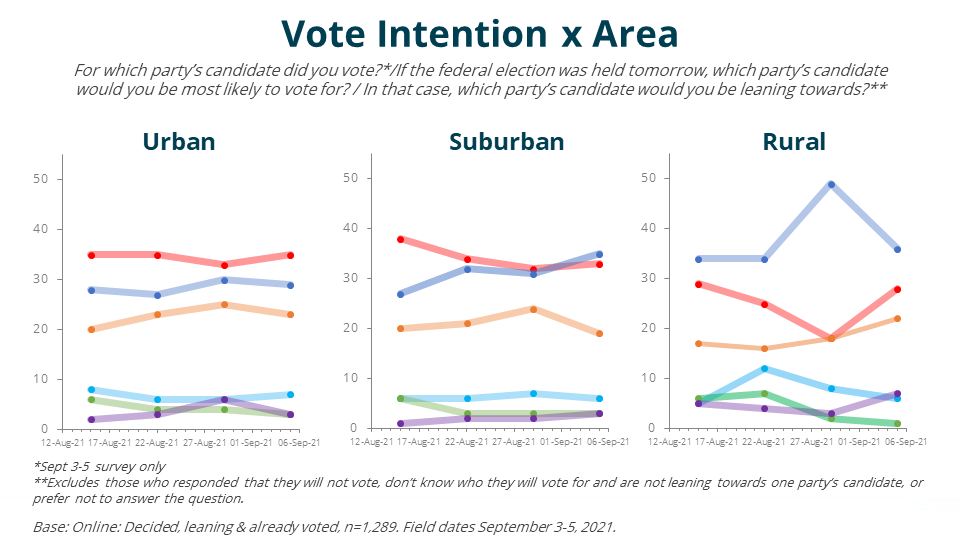
This survey was sponsored by Earnscliffe Strategy Group and conducted by Leger using a random sampling of panelists from Leger’s proprietary online panel. The survey was conducted with 1,521 individuals from across Canada between September 3 and 5, 2021. The data was weighted to be reflective of the Canadian population by age, region, gender, education and mother tongue (QC only, FR vs non-FR) based on 2016 Census data. Since this survey was conducted using an online panel, no margin of error may be calculated.Earnscliffe follows the CRIC Public Opinion Research Standards and Disclosure Requirements that can be found here: https://canadianresearchinsightscouncil.ca/standards/
Webinar Presentation Deck – September 10, 2021
View the survey questionnaire | Download the full data tables
